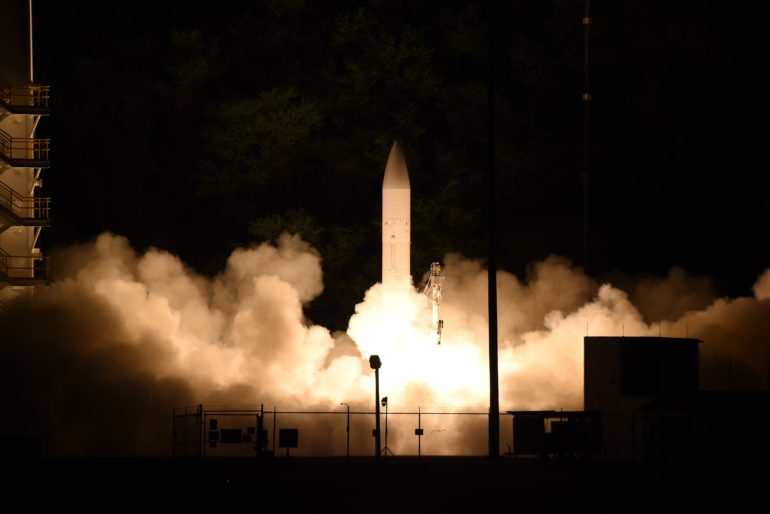[Photo Credit: U.S. Navy – On March 19, 2020, a joint Navy-Army team executed a successful flight test of a hypersonic glide body from the Pacific Missile Range Facility, Kauai, Hawaii.]
REDSONE ARSENAL, Ala. – On March 19, 2020, those on the ground at the Pacific Missile Range Facility, Kauai, Hawaii, had one thing on their mind: executing a successful hypersonic flight test.
The first launch of its kind in almost three years, the hypersonics team knew the importance of the flight test mission to support fielding capabilities by the early- to mid-2020s, a National Defense Strategy priority.
Even as the joint services, industry and national laboratory team celebrated on the ground, their concerns quickly turned to home. While in Hawaii preparing for launch, they knew the world around them had changed rapidly with the spread of COVID-19. Flights were being cancelled, students were moving to virtual learning, restaurants were closing and stay-at-home mandates were being implemented.
As they made their way home, they knew that even in light of their extraordinary achievement, the pandemic would be the next major challenge for the nation’s hypersonics team.
“When we came back, it was a very different environment than what it was a few weeks earlier when we first departed for the launch,” said Alex Roesler, deputy director for the Integrated Military Systems Center, Sandia National Laboratories. “We were immediately faced with questions on how could we safely conduct work and keep the program moving forward.”
Sandia National Laboratories, located in New Mexico, plays a critical role in the nation’s hypersonics program. As a national expert on hypersonics and the producer of the Common Hypersonic Glide Body (CHGB) that is at the heart of Army and Navy weapon systems, the team at Sandia is transitioning the build of the CHGB from a government-led effort to an industrial base-led effort to meet rapid prototype delivery timelines.
“The hypersonics program was on an already highly accelerated schedule,” said Col. James “Chris” Mills, Project Manager, CHGB for the Army Hypersonic Project Office (AHPO). “With COVID, we knew we had to adjust quickly.”
The AHPO, part of the Army Rapid Capabilities and Critical Technologies Office (RCCTO), is responsible for prototyping a land-based Long Range Hypersonic Weapon (LRHW) that will deliver residual combat capability to Soldiers by fiscal year 2023. The Army and Navy are partnered to execute hypersonics through use of the CHGB, with the Navy as lead for design and the Army as lead for production. The services are also linked through common missile design and joint test opportunities.
Unlike other manufacturers that could quickly adjust to the new pandemic reality by running multiple shifts to reduce headcounts or extending spaces to enforce social distancing, the work at Sandia thrived on a model where engineers and technicians worked side-by-side in small spaces, transitioning highly technical knowledge in hypersonics to their industrial partners.
Sandia had set up training classes for their industry partners in the fall of 2019. When COVID began to force shutdowns in 2020, they were in the middle of their second class.
In order to continue, they knew significant changes were needed.
After consulting safety, health and environment experts, Sandia adopted unique solutions to allow the training and production to continue. Moveable plexiglass barriers were brought in for makeshift viewing galleries, closed-circuit cameras recorded the integration work while engineers watched in separate rooms, and in the instances when social distancing couldn’t be consistently maintained, upgraded masks were issued.
As the RCCTO worked with Sandia to find ways to remain on schedule, the Army also reached out to industry partners who were busy implementing their own adjustments.
Dynetics, the prime contractor for the CHGB; and Lockheed Martin, the prime contractor for the Navy-Army All Up Round + Canister (AUR+C) and for the Army LRHW integration; both met challenges head-on, while staying in lockstep with the government.
The companies quickly implemented telework, established virtual meetings, accelerated payments to hypersonics suppliers – many of which are small businesses – and continued vital site visits when necessary.
For example, by utilizing virtual tools and other safety precautions, the Lockheed Martin Rotary Mission Systems facility successfully completed a milestone Critical Design Review for its canister production in October 2020. They accelerated requisite cash flow while working with a small business supplier, which enabled the company to achieve a required certification for a spray booth and cure oven, leading to the spray testing for first production runs. They also kept the new facility for the assembly, integration and testing of hypersonics in Courtland, Alabama, on schedule by working extended hours and weekends under COVID precautions.
For their efforts, Lockheed Martin is ready to deliver the first two training canisters in March 2021, two months ahead of schedule, keeping the hardware on-track for delivery to an Army battery later this year.
Dynetics, responsible for producing the country’s first commercially manufactured set of CHGB systems, kept a small team at Sandia, a decision that did not come lightly as COVID forced many travel restrictions, meaning the workforce often could not come home on weekends. Similarly, several subcontractors to Dynetics on the CHGB, including Lockheed Martin, Raytheon, and General Atomics, have provided onsite engineering support at Sandia to aid in meeting design and production deliveries.
This was also true for the team from Sandia, who came to Redstone in Huntsville just as the pandemic began another uptick in late 2020, so they could conduct CHGB testing and work with Dynetics. Later this year, Dynetics will take on the leader role with Sandia engineers looking over their shoulders as CHGB production moves to Huntsville. Dynetics, also a subcontractor to Lockheed Martin with responsibility to develop the launchers, outriggers, power generation and distribution for the LRHW ground platform known as the transporter erector launcher (TEL), continued working on the TEL integration by scheduling flexible hours and spreading their employees out in the factory with masks and distancing.
As Sandia and industry quickly adapted, the RCCTO government workforce also implemented a swift round of changes that allowed the hypersonics program to remain on pace. Offices shifted to remote work, meetings were moved to virtual platforms, and only mission essential travel continued.
Active engagement with industry at all levels remained vital to keep the project moving throughout the past year. On a daily basis the team met with supply chain leads, shifted process sequences to overcome delays, and ramped-up personal protective equipment and physical distancing to allow essential factory floor work to continue.
“We’re on such a tight schedule that constant communication remains critical,” said Col. Ian Humphrey, AHPO Project Manager for Integration. “Even if we don’t see people face-to-face, we’re keeping in touch to make sure everyone is on the same track. With this tight timeline if someone is going in one direction and it’s not the correct path, we don’t have time in our schedule to fix that, so we have to make sure everyone is moving in the same direction.”
For important milestones like Program Design Reviews and Critical Design Reviews, virtual platforms were used, sometimes with hundreds of people, and from teams across government agencies, industry and national labs who joined from remote locations throughout the country. And by thinking outside the box, the team began lining up multiple local suppliers when COVID caused interruptions with traditional ones.
They also pushed boundaries when it came to meeting protocols.
“Our project updates became joint calls between Lockheed Martin, their subs and my team,” Humphrey said. “For my counterpart at Lockheed Martin, that’s the first time he’s getting this information. It is raw data and it’s not always good. But this step saved valuable time because we knew immediately what was going on and could adjust on the spot.”
While the technical aspects of keeping a national priority program like hypersonics on-track remained paramount, what can’t be overlooked, say those involved, is the personal sacrifice. Those team members, across government, industry and the national lab, made the early decision that despite a national pandemic they would do what they could to uphold their piece of the program. This commitment enabled the Army to remain on-pace in delivering a first for the country: an experimental, prototype Long Range Hypersonic Weapon.
“This is really a good example of American ingenuity,” said Lt. Gen. L. Neil Thurgood, Director of Hypersonics, Directed Energy, Space and Rapid Acquisition, who oversees the RCCTO. “Government and industry, at all levels, have really done a great job of adjusting to protect the team and deliver on time.”

